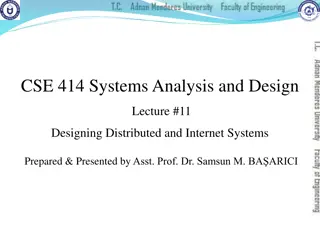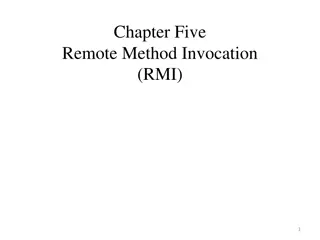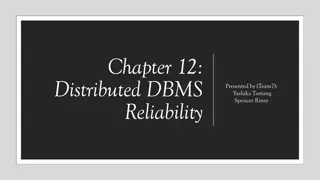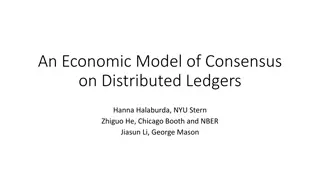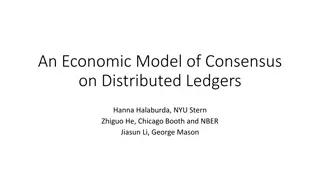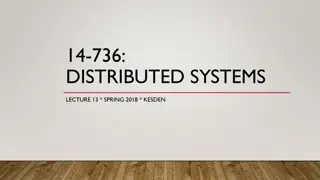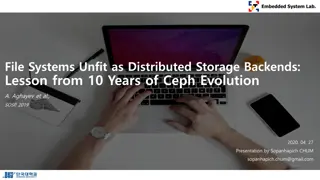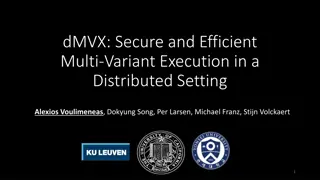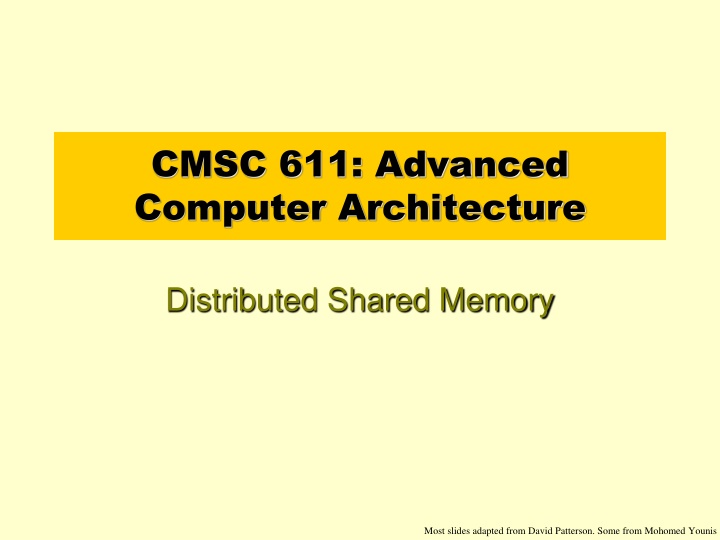
Advanced Computer Architecture: Memory Models and Scalability
This presentation discusses advanced computer architecture topics such as centralized shared memory, distributed memory, NUMA vs. UMA, shared address models, and fundamental issues in memory access. It explores the advantages and disadvantages of different memory models in supporting large processor counts, scalability, memory bandwidth, and latency reduction.
Download Presentation

Please find below an Image/Link to download the presentation.
The content on the website is provided AS IS for your information and personal use only. It may not be sold, licensed, or shared on other websites without obtaining consent from the author. If you encounter any issues during the download, it is possible that the publisher has removed the file from their server.
You are allowed to download the files provided on this website for personal or commercial use, subject to the condition that they are used lawfully. All files are the property of their respective owners.
The content on the website is provided AS IS for your information and personal use only. It may not be sold, licensed, or shared on other websites without obtaining consent from the author.
E N D
Presentation Transcript
CMSC 611: Advanced Computer Architecture Distributed Shared Memory Most slides adapted from David Patterson. Some from Mohomed Younis
2 Centralized Shared Memory Processor Processor Processor Processor One or more levels of cache One or more levels of cache One or more levels of cache One or more levels of cache Zero or more levels of cache I/O Memory Processors share a single centralized memory Feasible for small processor count to limit memory contention Model for multi-core CPUs
3 Distributed Memory Proc Proc Proc Proc Cache Cache Cache Cache Mem Mem Mem Mem Mem Mem Mem Mem Cache Cache Cache Cache Proc Proc Proc Proc Uses physically distributed memory to support large processor counts (to avoid memory contention) Advantages Allows cost-effective way to scale the memory bandwidth Reduces memory latency Disadvantage Increased complexity of communicating data
4 NUMA vs. UMA PE = Processing Element UMA = Uniform Memory Access Shared memory Same cost for any PE to access NUMA = Non-Uniform Memory Access All memory is associated with some PE Faster for that PE, slower for other PEs
5 Shared Address Model Physical locations Each PE can name every physical location in the machine Shared data Each process can name all data it shares with other processes
6 Shared Address Model Data transfer Use load and store, VM maps to local or remote location Extra memory level: cache remote data Significant research on making the translation transparent and scalable for many nodes Handling data consistency and protection challenging Latency depends on the underlying hardware architecture (bus bandwidth, memory access time and support for address translation) Scalability is limited given that the communication model is so tightly coupled with process address space
Three Fundamental Issues (#1: Naming) What data is shared? How it is addressed? What operations can access data? How processes refer to each other? Choice of naming affects code produced by a compiler Just remember and load address or keep track of processor number and local virtual address for message passing Choice of naming affects replication of data In cache memory hierarchy or via SW replication and consistency 7
8 Naming Address Spaces Global physical address space any processor can generate, address and access it in a single operation Global virtual address space if the address space of each process can be configured to contain all shared data of the parallel program memory can be anywhere: virtual address translation handles it Segmented shared address space locations are named <process number, address> uniformly for all processes of the parallel program
Three Fundamental Issues (#2: Synchronization) To cooperate, processes must coordinate Message passing is implicit coordination with transmission or arrival of data Shared address additional operations to explicitly coordinate: e.g., write a flag, awaken a thread, interrupt a processor 9
Three Fundamental Issues (#3: Latency & Bandwidth) Bandwidth Need high bandwidth in communication Match limits in network, memory, and processor Overhead to communicate is a problem in many machines Latency Affects performance, since processor may have to wait Affects ease of programming, since requires more thought to overlap communication and computation Latency Hiding How can a mechanism help hide latency? Examples: overlap message send with computation, pre-fetch data, switch to other tasks 10
11 Snooping Cache Coherency Send all requests for data to all processors Processors snoop to see if they have a copy and respond accordingly Requires broadcast, since caching information is at processors Works well with bus (natural broadcast medium)
12 Directory Cache Coherency Keep track of what is being shared in one centralized place Distributed memory distributed directory for scalability (avoids bottlenecks) Send point-to-point requests to processors via network Scales better than Snooping Actually existed before Snooping-based schemes
Distributed Directory Multiprocessors Directory per cache that tracks state of every block in every cache Which caches have a block, dirty vs. clean, ... Info per memory block vs. per cache block? simpler protocol (centralized/one location) directory is O(memory size) vs. O(cache size) To prevent directory from being a bottleneck Distribute directory entries with memory Each tracks of which processor has their blocks 13
14 Directory Protocol Similar to Snoopy Protocol: Three states Shared: Multiple processors have the block cached and the contents of the block in memory (as well as all caches) is up-to-date Uncached No processor has a copy of the block (not valid in any cache) Exclusive: Only one processor (owner) has the block cached and the contents of the block in memory is out-to-date (the block is dirty) In addition to cache state, must track which processors have data when in the shared state Usually bit vector, 1 if processor has copy
15 Directory Protocol Keep it simple(r): Writes to non-exclusive data = write miss Processor blocks until access completes Assume messages received and acted upon in order sent Terms: typically 3 processors involved Local node where a request originates Home node where the memory location of an address resides Remote node has a copy of a cache block, whether exclusive or shared No bus and do not want to broadcast: Interconnect no longer single arbitration point All messages have explicit responses
16 Example Directory Protocol Message sent to directory causes two actions: Update the directory More messages to satisfy request We assume operations atomic, but they are not; reality is much harder; must avoid deadlock when run out of buffers in network
Directory Protocol Messages 17 Type Read miss P has read miss at A; request data and make P a read sharer Write miss local cache P has write miss at A; request data and make P exclusive owner Invalidate home directory Invalidate shared data at A Fetch home directory Fetch block A home; change A remote state to shared Fetch/invalidate home directory Fetch block A home; invalidate remote copy Data value reply home directory Return data value from home memory Data write back remote cache Write back data value for A SRC local cache DEST home directory MSG P,A home directory P,A remote cache A remote cache A remote cache A local cache D home directory A,D
Cache Controller State Machine States identical to snoopy case Transactions very similar. Miss messages to home directory Explicit invalidate & data fetch requests 18 State machine for CPU requests for each memory block
Directory Controller State Machine Same states and structure as the transition diagram for an individual cache Actions: update of directory state send messages to satisfy requests Tracks all copies of each memory block Sharers set implementation can use a bit vector of a size of # processors for each block 19 State machine for Directory requests for each memory block
20 Example P2: Write 20 to A1 Assumes memory blocks A1 and A2 map to same cache block
21 Example P1 P1 A1 A1 WrMs DaRp A1 Ex {P1} 0 Excl. A1 10 P2: Write 20 to A1 Assumes memory blocks A1 and A2 map to same cache block
22 Example P1 P1 A1 A1 WrMs DaRp A1 Ex {P1} 0 Excl. Excl. A1 A1 10 10 P2: Write 20 to A1 Assumes memory blocks A1 and A2 map to same cache block
23 Example P1 P1 A1 A1 WrMs DaRp A1 Ex {P1} 0 Excl. Excl. A1 A1 10 10 P2 P1 P2 Shar. A1 RdMs Ftch DaRp A1 A1 A1 A1 10 10 10 Shar. 10 10 A1 Shar. A1 A1 Shar. {P1,P2} 10 P2: Write 20 to A1 Write Back Assumes memory blocks A1 and A2 map to same cache block
24 Example P1 A1 0 Excl. Excl. A1 A1 10 10 DaRp P2 P1 P2 P2 P1 Shar. A1 RdMs Ftch DaRp WrMs Inval. A1 A1 A1 A1 A1 A1 10 10 10 Shar. 10 10 10 10 A1 Shar. Excl. A1 A1 A1 Shar. {P1,P2} 10 20 P2: Write 20 to A1 A1 Inv. Excl. {P2} Assumes memory blocks A1 and A2 map to same cache block
25 Example P1 P1 A1 A1 WrMs DaRp A1 Ex {P1} 0 Excl. Excl. A1 A1 10 10 P2 P1 P2 P2 P1 P2 Shar. A1 RdMs Ftch DaRp WrMs Inval. WrMs A1 A1 A1 A1 A1 A2 A1 10 10 10 Shar. 10 10 10 10 0 A1 Shar. Excl. A1 A1 A1 Shar. {P1,P2} 10 20 P2: Write 20 to A1 A1 A2 Inv. Excl. Excl. {P2} {P2} P2 P2 A1 A2 20 0 WrBk DaRp A1 A2 Unca. Excl. {} 20 0 Excl. A2 {P2} 40 Assumes memory blocks A1 and A2 map to same cache block




